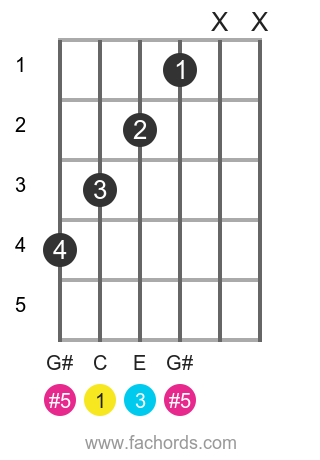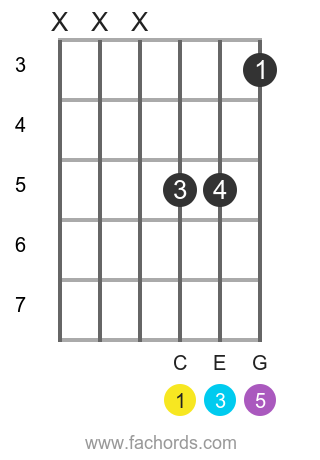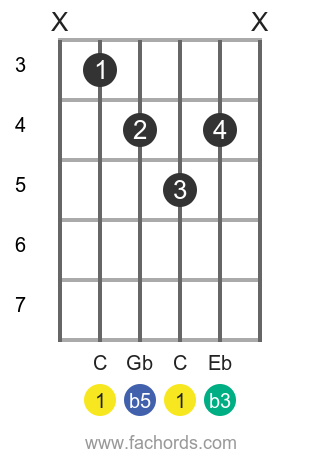Guitar Triads
Learn How To Play Triads On Guitar
In this tutorial, we're going to learn a smart music concept that every guitar player should know!
Triads are super useful in a lot of situations, like soloing across the entire neck, chord building, melodic phrasing, and so forth.
We're going to learn the four main types of triads: major, minor, diminished and augmented.
Let's begin!
Interactive Tool To Explore Guitar Triads Along The Neck
This tool shows you all the guitar triads mapped across the entire fretboard, check it out!
Guitar Triads Fretboard Patterns
Here below you find the shapes for all triads types. Play the 3 note groups surrounded by the green lines. This kind of visualization is useful to highlight how triads are connected along the fretboard.
Major Triads
Major triads are composed of the root, major third and perfect fifth.

Minor Triads
Minor triads are formed by the root, minor third and perfect fifth.

Diminished Triads
Diminished triads are built with the root, minor third and diminished fifth.

Augmented Triads
Augmented triads are created by stacking the root, the major third and augmented fifth.

Guitar Triads Recap Video
The video below shows you all the triads and their inversions (more about inversions later on this page) across the whole neck:
Guitar Triads | Music Theory Explanation
In music theory chords are represented by a harmonic set of three or more notes . These simplest three note chords are known as triads ; they form much of the basic building blocks of western music.
During this article we will breakdown the science of guitar triads : how to play triads on guitar , how to find triads shapes on the fretboard , and why it is so important to learn them.
In the late Renaissance music relied heavily on counterpoint techniques, which focused on melodic interactions, and less on harmonies.
With the rise of the triad , music became more oriented towards the specific and simultaneous soundings of particular notes, i.e. chords.
Regardless of the musical scale we play in, when we follow the rules of triads , we will have pleasant sounding chords and harmonies on our guitar!
What is a triad
Ok, triads seem to be cool, but what they really are? A triad is a set of three notes that can be stacked in thirds, lets use the simplest musical scale of C to break this all down.
A major triad is made up of the 1st or root note, the 3rd note, and the 5th note of a scale.
The C major scale consists of the notes:
C D E F G A B C
We can have major, minor, augmented and diminished triads, as we're going to see in the following of this article.
Using this scale we will find the notes of the C major triad:
C D E F G A B C
The root and 1st note is of course C the 3rd note as we count up the scale is E and the 5th note is G which makes the C major triad or C major chord C-E-G .
It is ok to label this interval either way, or even to simply call it the C chord.
Major Triads
A major triad is composed by stacking a major third (2 steps) and a minor third (1 and a half steps).
To create the C major triad using steps we start with the root note of C and move up two whole steps to get E and then we move up one half step and one whole step to get to G.
That is the formula for all major triads or major chords on any instrument , we find the root take two steps up to the 3rd and then one and a half steps to the 5th.
Using this simple formula for major triads we can find any basic major chords necessary.
Let’s say we want to find the G major triad , well the G major scale is:
The root note is G the 3rd is B and the 5th is D and if we look on the guitar fretboard we will notice that the same formula works again; two whole steps up to the 3rd with a half step plus a whole step to the 5th.
If all of that seems a little confusing, just take a moment away from reading and spend some time studying your fretboard . Try forming different major triads for other scales, and be sure to check your progress.
Next we will move on to minor triads... and if you have any frustration over music theory.
Remember there is method to all this madness.
By understanding the concepts of these triads your playing, skills, and even your ability to compose and solo will be greatly enhanced.
Minor triads
A minor triad is composed by stacking a minor third (one and a half steps) and a major third (2 steps).
Structure: Root, Minor Third, Perfect Fifth
Say we are playing a C major triad on our guitar, now we all know that major chords are often used for an uplifting and rocking feeling, but let’s say we want to change the mood of that chord .
How do we play the C minor triad/chord? Well of course we could just look it up, but it is a huge time saver to remember that a minor triad simply has a flattened 3rd note !
Before we had the C major triad made up of the 1-3-5 interval, which was C-E-G, now when we flatten the third note we get C-Eb-G , the C minor triad !
It is really that simple as 1-3b-5. Jumping from the major to the minor is simply cutting back a half step on the third note.
Now if we use the step method, a minor triad is one half and a whole step from the first to the third, and two whole steps from the third to the fifth.
Each time, with every single scale we pick, the minor triad or chord, will always be this same formula.
Above we mentioned the G major triad, so what would the minor be? After flattening the third it is G-Bb-D !
With knowing how to form all basic major and minor triads, our musical world has opened up immensely.
Now let's see the remaining triad types, diminished and augmented triads.
Diminished triads
A diminished triad is simply a minor triad with a flat 5th.
It is made up of the root note, a flattened 3rd, and a lowered or diminished 5th, thus a C dim chord will consist of C-Eb-Gb .
Structure: Root, Minor Third, Diminished Fifth
When you first hear a diminished triad played you will immediately notice how dramatic and even eerie it can sound.
There are a few different ways to notate this triad either as C diminished, C dim, or Cb5 .
Certain triad shapes are perfect for learning multiple chords on the guitar.
Let’s take the C dim shape above and move it two frets up, the notes will now be D-F-Ab, which is a D diminished chord.
As long as we stick to this same shape up and down the fretboard we will have a variety of diminished chords .
The diminished triad is most often used as an approach chord, waiting to be resolved by moving the 3rd and 5th one half step up.
Play the notes C-Eb-Gb and then move to C-E-G and you will see how nice this resolution sounds, it has an unstable quality just waiting to be wrapped up nicely.
Now, before we get into any specific examples let’s take a look at augmented triads.
Augmented Triads
An augmented chord is a major triad with a raised 5th.
So a normal C major C-E-G becomes the augmented or raised C-E-G# .
Structure: Root, Major Third, Augmented Fifth
This triad can be notated as C augmented, C aug, or C+ , like diminished triads they also have an unstable sound and are often looking to be resolved to another chord.
Just like the other triad shapes above we can move this shape up and down the guitar, always getting an augmented triad .
In fact, if we use the diminished triad shape we learned from above we can move that up to the regular C major triad and then raise the fifth up to the augmented C.
I personally like how it sounds to play this chord progression:
C Augmented

C Major

C Diminished

C Major

Because these chords have a bit of dissonance they are often used for a very short time, perhaps in passing for one beat or maybe one bar.
They work best as a leading tone into another chord, quite often the root or tonic.
These augmented and diminished chords create an anticipation and transition between normal major and minor triads.
They are to be used sparingly in most cases, a little goes a long way!
Sometimes songwriters also use these augmented and diminished chords to modulate between different keys in a song.
How To Use Triads To Advance Your Musicianship
Beyond expanding your knowledge of the guitar fretboard there are a couple of major benefits to triads .
1) Triads are useful for riffs and melodies
Arpeggios , melodies and riffs are all often composed using triads and their different shapes.
An arpeggio is playing a chord one note at a time as opposed to all at once, it can be played slowly or quickly, and in any order you want.
Instead of playing that 5th fret C major triad all at once, try plucking each string quickly one after another.
Arpeggios can sound beautiful like a harp solo, or they can sound like heavy metal when played fast enough (with some more distortion too!).
The three notes of each triad, the root, third, and fifth position make up much of the basic harmonies of all pop , folk , and rock music out there.
By just playing these triads in various positions on the guitar, you will have the chops to play in a simple band.
Drill Down: A great example of famous song built on triads, is Snow (Hey Oh) by Red Hot Chili Peppers, in which John Frusciante put together an awesome triads sequence.
2) Triads are the foundation for more complex chords
Over time you will want to expand on your triads , but you would be surprised how great you can sound with just the 3 note major and minor chords.
Many guitarists use these shapes to come up with new riffs, melodic lines, and of course for soloing.
Let's say your band has 8 bars of repeated chords C, G, and F... for a simple solo you can play each note in the triad of the chord you are in.
This is a great way to learn to solo and improvise , it is hard to go wrong with the notes in the basic triads of each chord!
Guitar Triads Inversion
We also must comment on inversions. Inversions deal with the relationship to the bass note of the triad.
1) Root position
- G Fifth
- E Third
- C Root
In a regular C major triad, the note order is C-E-G, with the C note being the bass note of the chord.
This chord is in its root position .
2) First inversion
- G Fifth
- C Root
- E Third
Sometimes we play a C chord shape on the guitar where the notes are arranged as E-C-G , this is still a C major triad, but it is known as the first inversion .
3) Second inversion
- C Root
- E Third
- G Fifth
If we have the G as the bass note , this is the second inversion.
These inversions allow us to play the same triad in different positions and allow for different musical voicing’s.
Any combination of Root, Third (major or minor) and Fifth (perfect, diminished, or augmented) forms a triad.
To see the shapes one at a time, you can use the interactive tool at the top of this page.
Video Demonstration with Tabs
The video below shows a little song that is a demonstration on how is possible to play a common chord progression , such as the classic C G Am F , all over the fretboard, using 3 strings triad shapes and the related inversions.
Notice how new shapes appear along the fretboard and the feeling created.
Download the Guitar Tab Pdf from the free download page
Diatonic Vs Not Diatonic Triads
We have just seen that a triad can be major, minor, augmented or diminished.
But what is the criterion to decide a triad type?
Introducing diatonic triads.
Diatonic triads are built using only the notes in a key.
For example, let's consider the C key, which consists of the notes: C, D, E, F, G, A, B, C.
To create a diatonic triad, we start on the first note (C), skip the second note (D), take the third note (E), skip the fourth note (F) and take the fifth note (G).
This gives us the notes C, E, and G, which create a Major Triad (a Major Third from C to E and a Perfect Fifth from C to G).
If we repeat the process starting from each degree in the scale, we will get the following triads:
- C E G - Major Triad
- D F A - Minor Triad
- E G B - Minor Triad
- F A C - Major Triad
- G B D - Major Triad
- A C E - Minor Triad
- B D F - Diminished Triad
The interesting thing is that in any major key, you will always have 3 major triads, 3 minor triads and 1 diminished triads.
To find more information, check this tutorial about chords construction.
Guitar Triads: Further resources
This concludes our journey into the fascinating world of triads and harmony.
Actually, learning triads is just the beginning: there are a lot of interesting things you can do, such as adding another tone and creating seventh chords , and other funny things, such as dyads, also known as double stops.
Here below you find more resources that will help you understand better guitar triads and the fretboard.
- Read the tutorial on fretboard theory , that will help you understand the fretboard layout.
- Enjoy our webapp for practicing fretboard intervals , it will help you internalize frets geometry.
To stay updated on new tutorials, subscribe to the free newsletter (you'll also get access to the download area with lots of free printable resources)